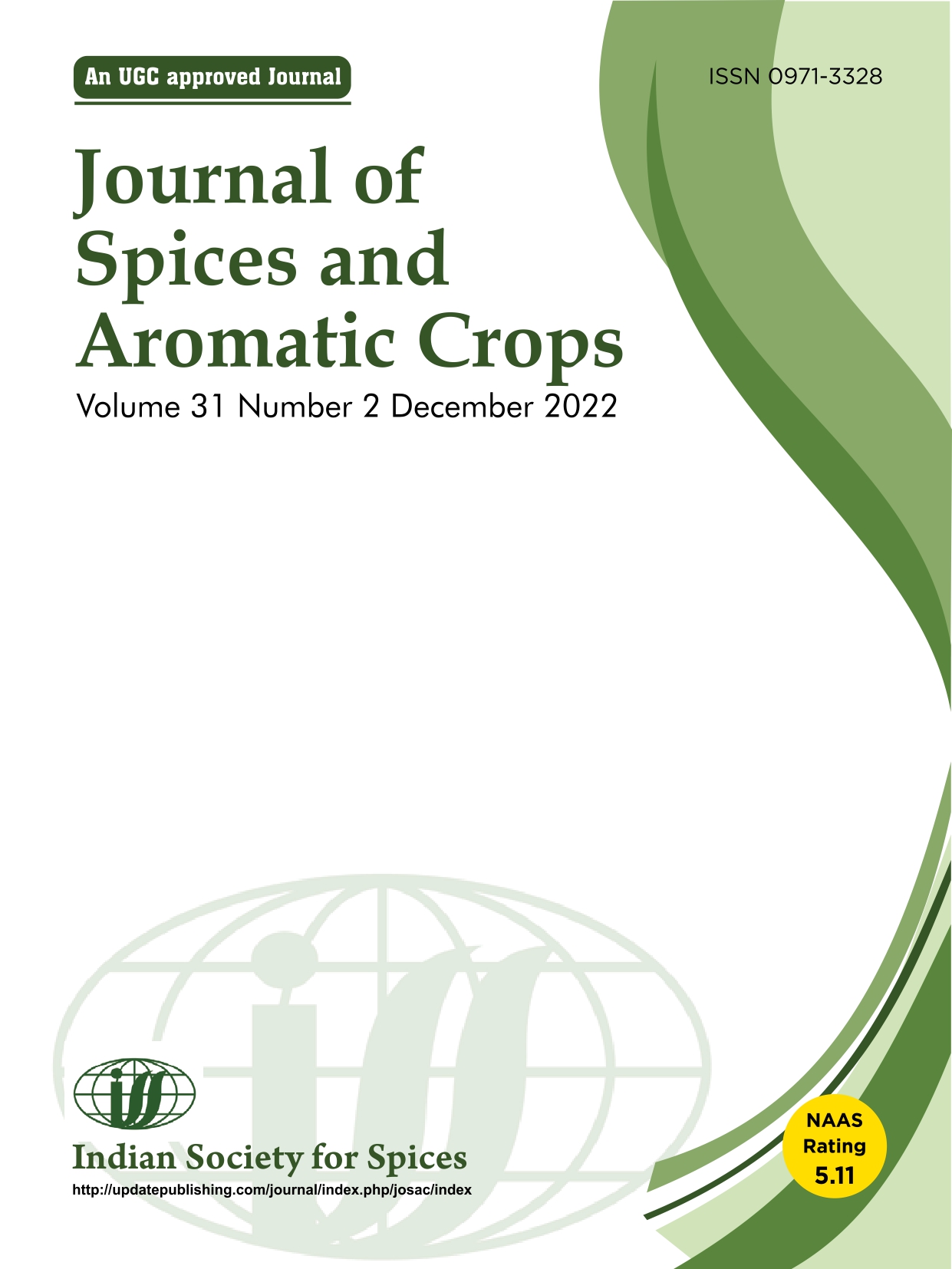Characterization of black pepper (Piper nigrum L.) varieties and landraces/farmers selections for spike and berry traits
Characterisation of black pepper for spice and berry traits
DOI:
https://doi.org/10.25081/josac.2022.v31.i2.8087Keywords:
berry components, landraces, correlation, principal components, Scott-Knott testAbstract
Statistical tools such as analysis of variance, correlation, path coefficient analysis, Scott-Knott test and principal component analysis were used in the present study to characterize black pepper verities/hybrids for spike and berry traits. ANOVA indicated that fifteen traits under study were statistically significant. Traits like fresh pericarp weight and dry pericarp weight showed high positive correlation (>0.95) with spike weight. Path coefficient analysis revealed that berry weight and seed size are contributing directly to spike weight. Scott-Knott test identified Panniyur-1 and Nedumchola as the most contrasting genotypes for most number of traits studied. Based on Principal Component Analysis (PCA), first three principal components had an eigen value above unity and explained 88 per cent of cumulative variation. Principal component PC-1 accounted for maximum variation of about 42.4 percent which discriminated the genotypes based on fresh berry weight, dry seed weight and fresh pericarp weight. These traits serve as the selection criteria for improvement of yield in black pepper.
Downloads
References
Attokaran M 2017 Black Pepper: Natural food flavors and colorants, John Wiley & Sons, United Kingdom, pp. 87–93.
Chen Y S, Dayod M & Tawan C S 2018 Phenetic analysis of cultivated black pepper (Piper nigrum L.) in Malaysia. Int. J. Agron. 1–11
Bekele D, Andargachew G & Haimanot M 2017 Morpho-genetic variability and character correlation among thirteen black pepper accessions. Int. J. Agri. and Fores. 7(2): 52–55.
Ibrahim K K, Pillai V S & Sasikumaran S 1985 Path coefficient analysis of some yield components in black pepper (Piper nigrum L). Indian Spices. 22: 21–25
Ibrahim K K, Pillai V S & Sasikumaran S 1985b Genotypic and phenotypic correlation among yield and its components in black pepper (Piper nigrum L.). Agric. Res. J. Kerala, 23: 150–153.
Jelihovschi E G, Faria J C & Allaman I B 2014 Scott Knott: A package for performing the Scott- Knott clustering algorithm in R, Trends in Appl. Compu. Math, 15(1): 3–17.
Kaiser H F 1960 The application of electronic computers to factor analysis. Educ psycho Measmt. 20: 141–151.
Mangalakumari C K, Sreedharan V P & Mathew A G 1983 Studies on blackening of pepper (Piper nigrum L.), during dehydration. J. Food Sci. 48 (2): 604–606.
Mathew P J, Mathew P M & Kumar V 2001 Graph clustering of Piper nigrum L. (Black pepper). Euphytica 118: 257–264.
Pradeepkumar T, Sajith Babu D, Aipe K C & Mathew S 2003 Clonal variability in black pepper hybrid panniyur 1. J. Spices Arom. Crops, 12 (2): 154–157.
Preethy T T, Aswathy T S, Sathyan T, Dhanya M K & Murugan M 2018 Performance, diversity analysis and character association of black pepper (Piper nigrum L.) accessions in the high altitude of Idukki district, Kerala. J. Spices Arom. Crops. 27 (1): 17–21.
Ravindran P N, Balakrishnan R & Nirmal Babu K 1997a Morphometrical studies on black pep per (Piper nigrum L). 1. Cluster analysis of black pepper cultivars. J. Spices Arom. Crops, 6 (7): 9–20.
Ravindran P N, Balakrishnan R & Nirmal Babu K 1997b Morphometric studies on black pepper II. Principal component analysis of black pepper cultivars. J. Spices Arom. Crops 6 (7): 21–29.
Ravindran P N, Nirmal Babu K, Sasikumar B & Krishnamurthy K S 2000 Botany and crop improvement of black pepper. In: Ravindran P N (ed.) Black pepper (Piper nigrum L.) (pp. 23-142).
Sasikumar B, Saji K V & Johnson K G 2007 Spike proliferation in black pepper (Piper nigrum L.). Fruits 62: 325– 328.
Shivakumar M S & Saji K V 2019 Trait association and path coefficient analysis among yield attributes and berry yield in black pepper. J. Spices Arom. Crops, 28(2): 106–112.
Shivakumar M S, Subraya K K, Vijayan S K & Bhaskaran Pillai S 2021 Pericarp as a new berry trait to define dry recovery and quality in black pepper (Piper nigrum L.). Sci. Hortic, 281(1): 109923
Scott A J & Knott M 1974 A cluster analysis method for grouping means in the analysis of variance. Biometrics, 30: 507–512.
Published
How to Cite
Issue
Section
Copyright (c) 2023 M S Shivakumar, S Aarthi, H J Akshitha, K V Saji, K S Krishnamurthy , B Sasikumar

This work is licensed under a Creative Commons Attribution-NonCommercial-NoDerivatives 4.0 International License.






 .
.